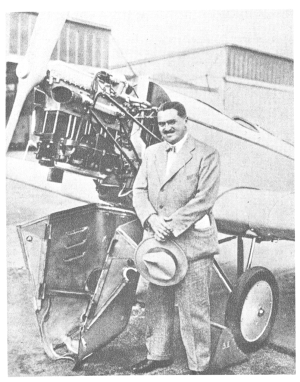
Hellmuth Hirth, born in 1886 in Heilbronn, was the most successful German pilot before World War I. When he was 18 years old, he worked as a mechanic with Edison in the USA. He returned to Germany in 1909 and joined ‘Erler’ where he helped to build the first German airplanes. In 1910 he built his first own designs and was a designer of airships at ‘Luftschiffbau Zeppelin’ later on.
Hirth founded ‘Elektrometall GmbH’ (now Mahle) which was engaged in the production of pistons, aircraft brake wheels, and air and oil filters. He left the company to found ‘Hirth Motoren GmbH’ in 1927. His first engine HM 60 with four inverted cylinders, crankshaft with Hirthtooth system and complete antifriction bearing application proved to be very reliable and successful in the flying competition ‘Deutschlandflug’ in 1931.
 The HM 60 R - the result of further development - was more powerful and even more successful than its predecessor. Soon the one-thousandth HM 60 R was delivered. Each cylinder had a piston capacity of one litre and the same control parts. The crankshaft was assembled from many serrated parts to save production costs. More engines with 4, 6, 8 and 12 cylinders followed. The HM 60 R - the result of further development - was more powerful and even more successful than its predecessor. Soon the one-thousandth HM 60 R was delivered. Each cylinder had a piston capacity of one litre and the same control parts. The crankshaft was assembled from many serrated parts to save production costs. More engines with 4, 6, 8 and 12 cylinders followed.
Hellmuth Hirth lost his life in an aircrash on 1st July 1938. First the Reichsministry of Civil Aviation became the trustee of the company, and on 9th April 1941 ‘Hirth Motoren GmbH’ was taken over by ‘Ernst Heinkel AG’. After WW II the defeated Germany had to stop manufacturing aircraft engines as the result of the production constraints implied by the allied forces. ‘Ernst Heinkel AG’ and ‘Hirth Motorenwerke KG’ started building small and robust 2-stroke engines for vehicles and stationary applications.
-Hellmuth Hirth pictured next to an HM 60R engine
In 1974, the company ran into difficulties because of its dependency upon the American market (hundreds of engines were built every day for snowmobiles) and the severe devaluation of the dollar caused by the oil crisis. Hans Göbler acquired all the production rights, and the former ‘Hirth Motorenwerke KG’ became ‘Göbler-Hirthmotoren KG’. When the Ultralight and light plane market experienced a revival in the eighties because of the use of 2 cycle engines, the company rediscovered its roots and decided to combine their aircraft engine technology and industrial 2 cycle technology to develop 2 cycle engines specifically for use in light plane applications. Thus the foundation for a wide range of products was laid again.
|

|